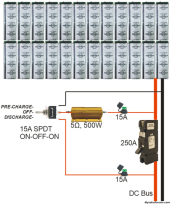JBertok
Network Engineer
Recently a bank of 24 Nesscap 3500F Supercapacitors was added to my system to assist with DC ripple and surge loads. Although a big investment, their performance and the preservation of battery longevity they provide is worth it, in my opinion. These capacitors will easily pass 1500 Amps and would look like a short circuit if just connected to the DC bus - resulting in welded breakers, likely damage to the inverter(s), fire, death, etc. These things can make rail guns - they are no joke! A pre-charge resistor is mandatory. I thought I would share what I did for those considering this upgrade.
For 48V nominal Systems:
Flooded Lead Acid - (24) 2.7V Super capacitors in series required for support up to 64.8V
Lithium Iron Phosphate - (22) 2.7V Super Capacitors in series required for support up to 59.4V
A 5 ohm 500 watt resistor when connected at a battery voltage of 52V will take 10.4A and about 540W. The wattage and amperage begins to fall off as the capacitor bank voltage begins to rise, and the wattage passing through the resistor will be a product of the voltage difference between the DC bus and the capacitor bank. At 50V delta it's 500 watts for a 4 ohm resistance; I consider the momentary over-rating of the 500W resistor acceptable. The resistor does get quite warm at first but the power running through it tapers off logarithmically.
In practice, the circuit below takes over 3 hours to pre-charge a bank of twenty-four 3500F capacitors up to the DC bus voltage. The same is true for discharge, and the voltage of the capacitor bank should be monitored before closing the big 250A breaker to bring the capacitors online. (I have a panel-mount DC Volt Meter to monitor Capacitor Bank voltage. Anything will do.)

For 48V nominal Systems:
Flooded Lead Acid - (24) 2.7V Super capacitors in series required for support up to 64.8V
Lithium Iron Phosphate - (22) 2.7V Super Capacitors in series required for support up to 59.4V
A 5 ohm 500 watt resistor when connected at a battery voltage of 52V will take 10.4A and about 540W. The wattage and amperage begins to fall off as the capacitor bank voltage begins to rise, and the wattage passing through the resistor will be a product of the voltage difference between the DC bus and the capacitor bank. At 50V delta it's 500 watts for a 4 ohm resistance; I consider the momentary over-rating of the 500W resistor acceptable. The resistor does get quite warm at first but the power running through it tapers off logarithmically.
In practice, the circuit below takes over 3 hours to pre-charge a bank of twenty-four 3500F capacitors up to the DC bus voltage. The same is true for discharge, and the voltage of the capacitor bank should be monitored before closing the big 250A breaker to bring the capacitors online. (I have a panel-mount DC Volt Meter to monitor Capacitor Bank voltage. Anything will do.)

Last edited:


